Post-Alpha we looked into how players engaged with the creatures of the world through combat. Our combat system required learning the unique move of each creature type, which provided an interesting first-time experience. However, over the course of hours of gameplay, players felt the single-move combat mechanics of creatures grow old and boring. This is how we addressed it without going too HARDCORE.
Combat design in crafting games is frequently an extension of the harvesting system; the only difference is that the object being harvested is moving and damages the player on contact. This is the case in games like Terraria, Minecraft, and Starbound. With little exception, it is the rule in the most popular of crafting titles that killing an enemy bears a striking resemblance to mining; You're mining living entities that don't take well to drilltips.
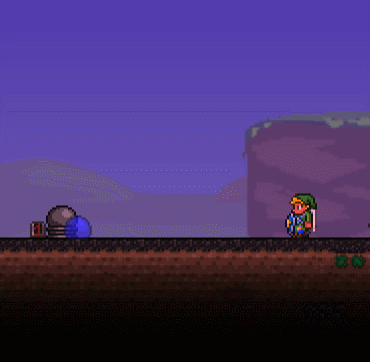
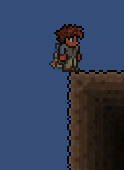
Combat and harvesting in many crafting games feel quite similar. Terraria gets away from this problem by introducing ranged weapons and spells later in the game.
We wanted Crashlands' combat system to engage players at a high skill level, but still maintain enough ease of play that it wasn't exhausting to repeat. It had to be accessible, allow for player mastery, and offer another dimension to the play experience not found in harvesting activities.
Don't Starve has many of these qualities, short of accessibility. For example, it's unclear how far the Bunny Man's bite reaches, something a new player would have to discover the hard way.
Combat, as it was
Each creature had a single move at its disposal. Once engaged, the creature would place a large overlay on the ground, showing the range and size of their move. Players would then have to "Dance" around these overlays to strike at foes. We called this the "Dance of Death". In the case of the Glutterfly, it went like this:
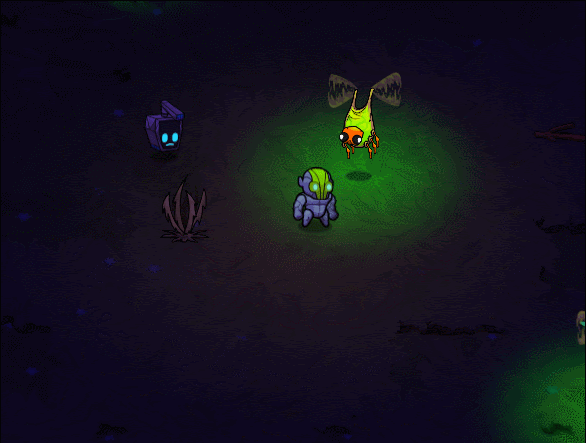
The Glutterfly's overlay gets more solid as it prepares to unleash its projectile, which has its own overlay style to show the danger radius.
This system was simple for new Players to pick-up and lent each creature, with its separate timing and effect types, a feeling of uniqueness. It also gave combat a distinctly different feel compared to harvesting.
This combat system stayed enjoyable so long as the flow of new Creatures was refreshed fast enough. However, for the Game-at-Large to remain interesting, the rate at which the player moved from one set of Creatures and Resources to another had to slowly grow longer, in order to ramp up the intensity of earning a reward.
This is similar to how going from Level 1 to Level 2 in an RPG takes a minute or two, whereas going from Level 89 to Level 90 can take a full day of playtime. The satisfaction of each is dependent on, and proportional to, the work required. Early, short gains are often used to teach the fundamentals of the game, whereas later gains are designed to further a sense of accomplishment and a feeling of Mastery.
And here lies the culprit; Combat was only interesting so long as there were new creatures to learn from, but those creatures were limited in supply and arrived at further and further time intervals as the game progressed. The system we devised offered Mastery potential, but not enough to weather those longer stretches between new creatures. We needed to kick it up a notch.
The Spice of Life
We'd already decided that we like the combat mechanics, just not how they age. For new players, the sense of bored Death-Dancing seemed to be setting in around 4 hours into the game, a scant 10% of the way through its intended duration.
How could we increase the lifespan of engaging combat without swinging the pendulum into "Too Difficult" territory?
We could reinvent the combat system, add more creatures (and thus more armor, weapons, etc.), or create sub-types of each creature... but all these would be an enormous undertaking. We needed to change the feel of combat across the board, but with the minimal work possible.
When, on a hunch, Seth changed the attack code of the Wompits to have a small randomization in landing accuracy, we saw what we'd been missing.
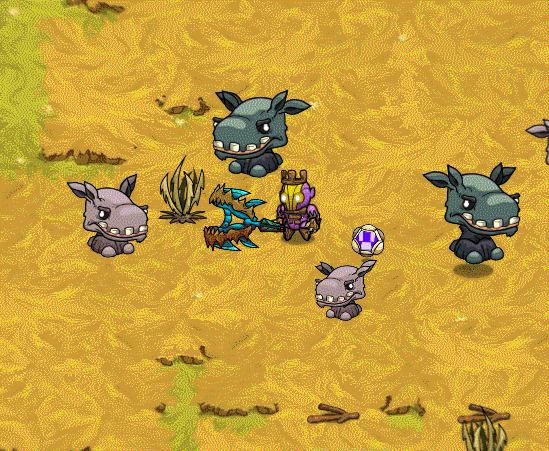
The three Wompits here land in slightly varied locations, rather than completely on top of the player.
Variety. And just the tiniest bit.
Over the following day Seth added some "wobble" to every Creature's attack. But we found this slight variation in execution wasn't quite enough. While it created variety in execution, it didn't deliver a variety in response.
In a small creature overhaul, we generated a list of secondary attacks: Glutterflies, the one-shot poisoners from before, could now fire a 3-shot burst; Wompits, the one-stomp fatties from above, could now perform a second, larger stomp in rapid succession after their first; etc.
We didn't want to lose that precious "wobble" though, so we gave the attacks a random chance of being selected.
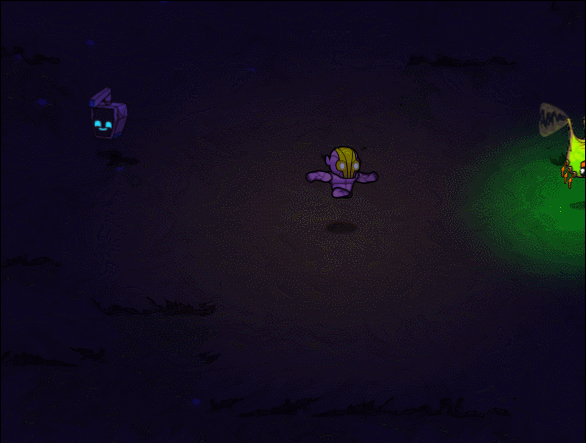
The Glutterfly now occasionally fires a multi-shot volley, requiring a change in player combat approach.
The end-all effect of this is that combat is more consistently interesting, because while you may know what the Creature is capable of, it's a roll of the dice in determining what it's going to choose to do. It's a subtle way to boost the Mastery potential of combat while keeping it accessible, and distinct from harvesting.
We think you're going to love it.
Stay tuned for parts 3 & 4 on the updates to Crashlands, and get your BscotchID. You'll need it to enter the Beta...SOON. :D
If you missed part 1, about Recipes, check it out here.



